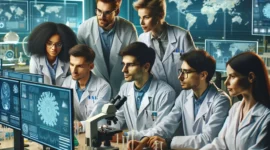Academician Ülo Lepik has, by this year, been active in the field of research and development for 68 years, and he has a pioneering role in the optimisation of the plasticity theory and construction elements. To a large extent, we have him to thank for the position Estonian mechanics held on both sides of the Iron Curtain and still holds today.
Academician Raimund-Johannes Ubar’s greatest contribution to the Estonian research and engineering community has been the founding of an internationally renowned school of research. The binary decision diagrams he implemented nearly 40 years ago caused a global boom in computer science. By now, these have become one of the most important theoretical models in digital system design and diagnostics.
The annual awards for the best research works completed and published in the previous four years were presented to:
- Urmas Nagel and Toomas Rõõm—in exact sciences for the research cycle “Interaction of THz radiation with magnetic excitations”. Their research is focused on the unusual effects of extremely high magnetic fields in various solid bodies, and the electric and magnetic processes happening in these. The possibilities of the THz spectroscopy they use have broadened the overall understanding of matter behaviour and light interaction, and may open the way for potential new applications.
- Tõnis Kanger—in chemistry and molecular biology for the research work “Asymmetric organocatalytic cascade reactions”. The application of organocatalysis has led to the creation of several new reaction paths; the identification of project mechanisms has provided the opportunity for the targeted directing of the mechanisms. The new discovered reactions and developed synthesis paths have already been realised in creating components for new antiviral and antibacterial as well as nervine medications.
- Maarja Kruusmaa—in technical sciences for the research cycle “Movement and senses of biologically inspired underwater robots”. Her research in the field of underwater robotics has offered solutions that enable underwater vehicles to autonomously cover distances as well as position themselves and make important decisions independently. The key factor in the research has been the lateral line—a flow-sensitive fish organ.
- Sulev Kõks and Külli Kingo—in medical science for their research and development work “Pathogenesis of chronical inflammatory skin disease”. The crowning achievement of their research cycle was the discovery of the important role of congenital immunity, which has greatly influenced the understanding of chronical inflammatory skin disease pathogenesis.
- Martin Zobel (team leader), John Davison, Mari Moora, Maarja Öpik—in geology and biology for the research cycle “Factors influencing plant and fungal community diversity and their interrelations”. The team was the first in the world to adequately describe the quantitative connections between plant biodiversity and ecosystem productivity. They decoded the role of a mysterious fungi group invisible to the naked eye—the so-called arbuscular mycorrhiza—in the life of plant communities, the variation of this fungi group’s biodiversity on the global and regional scale, and the risks the impoverishment of these communities pose for our nature.
- Arne Sellin—in agricultural science for the research cycle “The impact of climate change on trees’ water exchange, growth and the condition of forest ecosystems”. His research highlights the previously unknown effects of climate change on our forests. The rise in air humidity caused by additional precipitation limits nutrient absorption and decreases the photosynthetic capacity and growth of deciduous trees. In addition, the trees that have become accustomed to a more humid air have higher respiration costs. Identifying this reaction in hemiboreal forest stands allows specifying the prognoses for the forests’ condition and implementing necessary proactive measures.
- Tiina Randma-Liiv—in social studies for the research work “Challenges to Estonia’s state administration in the context of European comparative studies”. Based on a comparative analysis of austerity policies that 14 European states used during the economic crisis, Randma-Liiv offers several solutions for organising cooperation between state agencies in a better manner, reacting to crisis situations and managing budget cuts both in Estonia as well as on a wider scale in the European Union.
- Tõnu-Andrus Tannberg—in the humanities for the research cycle “The military history of Estonia” and “The history of Estonia in the Soviet period”. His research, which is based on successful work in the archives, connects material on Estonian history with the specific context of world history. His approach on Soviet power and the operational mechanisms of repressive bodies and armed resistance in Estonia, the presentation of the role of the Baltic Provinces in the formation of the armies of the Russian Empire, as well as the demonstration of the importance of Estonian-born men’s military experience in establishing the Republic of Estonia are valued as trustworthy and skilfully analysed sources of historical data.
National research awards will be presented on 24 February in Tallinn at the hall of the Estonian Academy of Sciences.
Original post (in Estonian) from the Estonian Academy of Sciences
This article was supported by the European Regional Development Fund through Estonian Research Council.
 Back
Back


